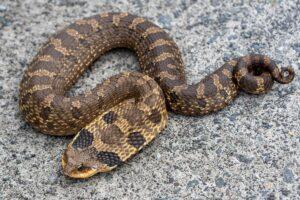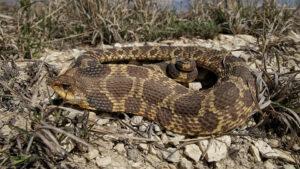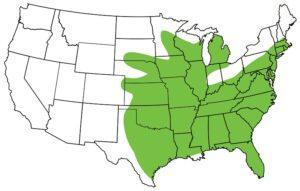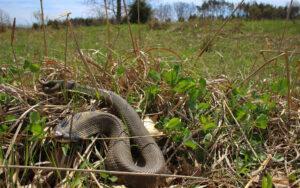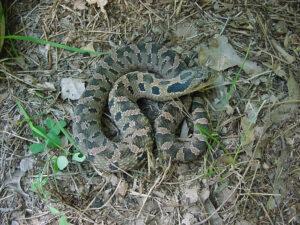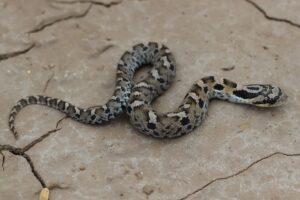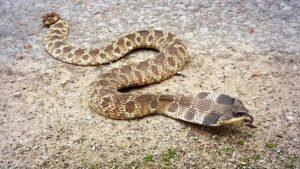The eastern hognose is a rear-fanged colubrid snake native to North America. Though their venom is too weak to be dangerous to humans, these snakes are sometimes known as spreading adders because of their habit to ‘hood’ when threatened. Other names include black hog-nosed snake, blowing adder, bastard rattlesnake, and buckwheat-nose snake.
Though they are currently listed as Least Concern by IUCN, concern about their declining population is rising, especially in the northeastern range. Habitat loss is one of the biggest threats, along with road mortality and intentional killing.
Scientific Classifications
- Suborder:Serpentes
- Family:Colubridae
- Genus:Heterodon
- Species:H. platirhinos
Conservation Status
Subspecies and Morphs
There are no recognized subspecies, but a popular snake kept as pets, there are several hognose morphs, including:
- Anaconda
- Albino
- Axanthic
- Toffeeconda
- Lavender
- Jaguar
- Pink Pastel
- Red Albino
- Super Arctic
- Extreme Albino
- Albino Anaconda
- Snow Western
Description
Size
These relatively small yet stout-bodied snakes can grow between 20 inches and 30 inches (50-75cm) in length, with females being larger than males. The longest recorded eastern hognose snake was a 46 inches (116cm) long female.
Color and Appearance
It has a broad triangular head, with the upturned snout characteristic of all hognose snakes.
The colors can vary significantly based on where they live. The base color can be anything from yellow, red, orange, brown, and green to gray and black, with darker rectangular blotches down their backs. Some may even have a solid black or gray coloration.
The light yellow, grayish, or cream-colored belly has no markings except an even lighter coloration under the tail.
They have keeled scales. There is a bulge just before the tail, near the cloaca in males, after which the tail tapers off drastically. On the other hand, females lack the bulge, with their tails thawing a smoother tapering.
Are they Dangerous to Humans
The eastern hognose snake is not dangerous to humans in any way because they don’t bite, even for self-defense.
Their mild venom comes from the Duvernoy’s gland instead of a traditional venom gland. Even if they bite a human, there will be no symptoms other than some local swelling and discomfort. For this reason, the species is often considered non-venomous.
Eastern Hognose Snake at a Glance
Habitat
Dry woodlands with loose sandy soil where they can easily make burrows and make nests. They may also inhabit farmlands, coastal areas, and dry fields.
Studies have shown their home range to spread as wide as 100 acres. Sometimes, the snakes might even travel outside their home range to breed.
Predators
Birds of prey, larger snakes, and carnivorous mammals, including raccoons and opossums.
When threatened or cornered, the eastern hognose raises and flattens its head while making loud hissing noises. It is somewhat similar to what a cobra does, except these snakes keep the head parallel to the ground instead of raising it vertically.
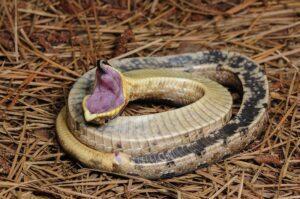
In its display of aggression, the snake then strikes its enemies repeatedly at high speeds. Still, they usually don’t try to bite.
If the above measures fail to ward off the enemy, the snake will then roll over and play dead with its belly up and tongue sticking out. It can even emit a foul-smelling musk to make the act look more realistic.
Diet
Primarily amphibians, including toads, frogs, and salamanders, as well as insects, rodents, and other small mammals.
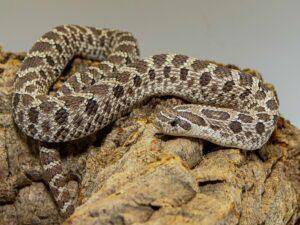
Since they are particularly fond of toads, they have specific adaptations for hunting and feeding on them. The toxic secretions from their Duvernoy’s gland effectively neutralize the poisons secreted by toad skin. And then, their rear fangs help them deflate a blown-up toad to swallow it easily.
Reproduction
Oviparous (egg-laying)
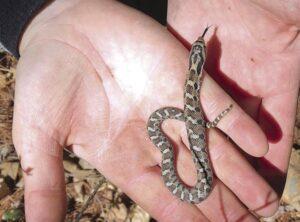
Mating takes place in April and May, with females laying around 10-40 eggs around June-July. The average clutch size is 25, and the eggs are laid in sandy burrows or under rocks. The females do not take care of the eggs and have sometimes been observed to prefer communal nests rather than nesting on their own.
The eggs hatch after around 2 months, with the hatchlings being 6-8 inches (15-20 cm) long. The Juveniles take approximately 2 years to reach maturity.
Care Sheet
Size of the Enclosure: A 30-50 gallon tank would be enough to house one adult.
Temperature: Daytime temperature should be between 70°F and 82°F, while it can drop to the high 60s at night. Keep the basking spot at 92°F-95°F.
Humidity: 50%-60%
Substrate: Since the snake likes to burrow and bury itself, aspen shavings, dry oak and maple leaves, and folded dry newspapers work well as the substrate.
Source
msherps.com, ak.picdn.net, images.squarespace-cdn.com, sdherps.org, live.staticflickr.com, webapps.fhsu.edu, scparc.org, townnews.com, images.fineartamerica.com, herpsofnc.org

